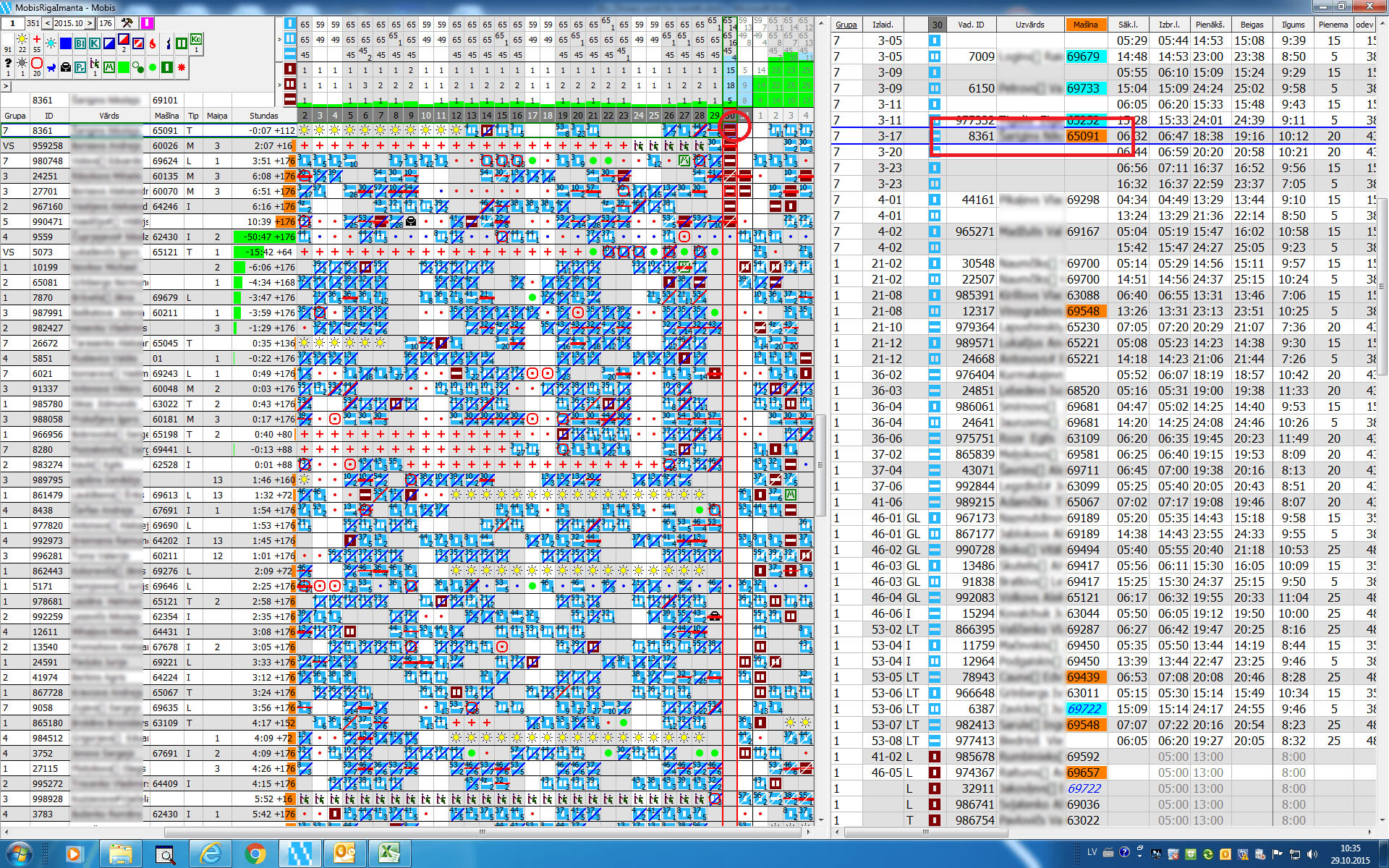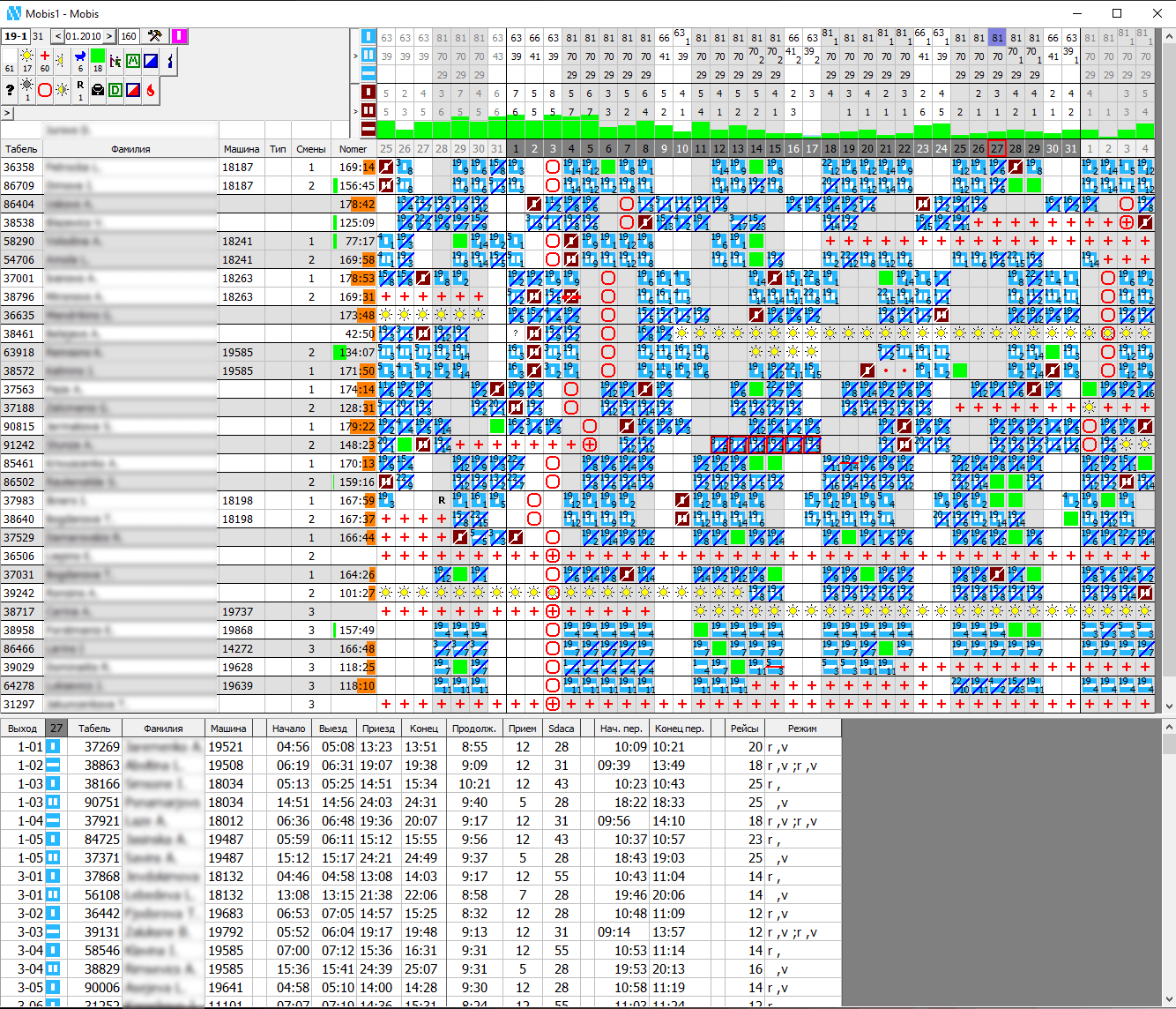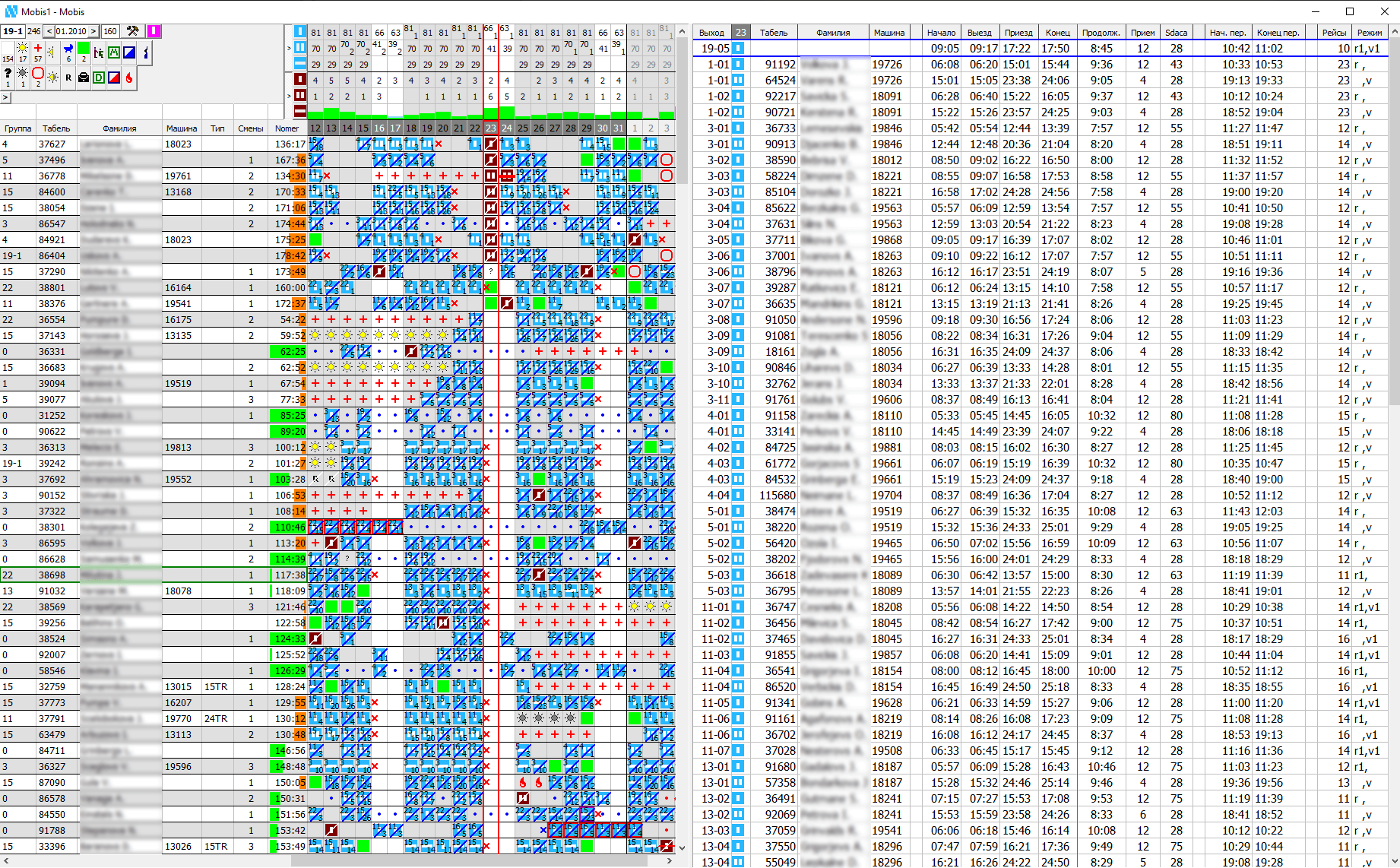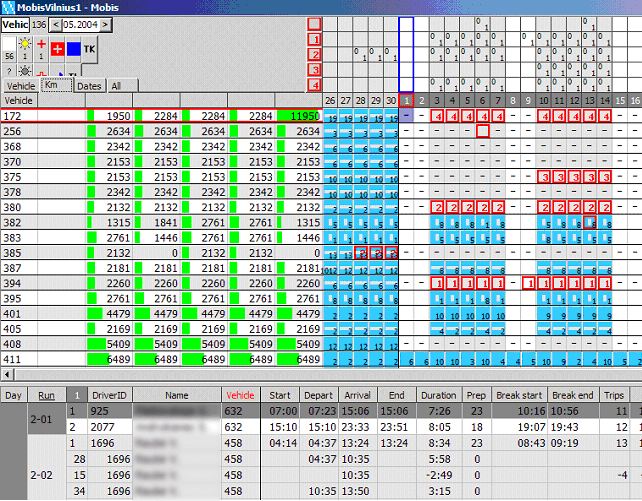PikasMOB
The system “PikasMob” consists of the two modules:
1. “PikasMob”, designed for planning and accounting of drivers’ work,
2. “PikasREM”, designed for preventive inspection of vehicles and planning of scheduled and overhaul repairs following actual mileage data.
“PikasMob” is designed for work planning of drivers at large and medium-sized public transport companies following traffic timetables. The planning consists of two parts:
A) definition of driver work plan for a month including assessment of various factors known in advance, and
B) real-time planning/adjustment of the selected days of a month referring to constantly changing circumstances – illnesses of drivers, holidays, absences at work, breakdowns of vehicles, urgent changes to timetables due to repairs on streets, etc.).
System advantages:
- Well-developed and time-tested algorithm (started in 2000 and still being developed).
- New requirements to drivers work planning are fully met.
- Introduction of new technologies and options, simple integration into any database. For example, “Pikas” and “PikasMob” has a close link with databases of programs, created by the company „SWARCO“.
- Comprehensive reports on the work performed by drivers, vehicles, routes.
- Close link to the application „Pikas“, designed for traffic planning purposes.
- Close link to the application „PikasREM“, designed for planning of technical, preventive inspections and repairs of vehicles.
- Close link to the application „Rehv“, designed for accounting of tires.
- Original and convenient graphical editor of the monthly work plan and individual days

 .
. - Adapted to conditions of the Baltic States and Eastern countries which significantly differ from other European regions.
Available functions:
- Import of normative data and data about traffic timetables.
- Establishment of monthly work plans for drivers according to provided traffic timetables (applying a mathematical work and rest time optimization algorithm).
- Adjustment of the established work plan (for any day of a month or a group of days).
- Entering of actual data about deviations from the traffic plan (changes of trolleybuses or their drivers, entering of downtime and other events).
- Accounting of traffic indicators of trolleybuses, drivers and all routes comparing target and actual data about traffic (generating of indicators in EXCEL format according to the format of reports preferred by the client). Example of summary of the work done by drivers
 .
.
Possible work and rest schedules for drivers:
A work and rest schedule indicates how many workdays in a row a driver is allowed to work, and how many rest days he deserves. Work and rest schedule of drivers may be defined by a combination of one or several parameters listed below:
- Figure 2, 3, 4, 5 or 6 means the quantity of workdays. It means that a driver will work the specified quantity of workdays in a row, and then he will have a rest day (days).
- A combination of figures, e.g. 45, means a varying quantity of workdays. It means that a driver will work 4 workdays followed by a rest day (days), then he will work 5 days followed by a rest day (rest days), then 4 days, etc.
- A figure with a plus sign, e.g. +1 or +2, means quantity of rest days. It means that a driver correspondingly needs one or two rest days. If it is not specified, two rest days are to be given.
- An asterisk (*) means that rest days on weekends and during holidays are to be given to a driver. It means that a driver will actually work only on calendar workdays.
- An equality sign (=) means that a driver has to work following the same schedule on all consecutive workdays (from one rest day to another).
Sample descriptions of driver’s work and rest schedule:
- 5+2 or simply 5 – five workdays followed by two rest days, etc.
- 45+1 – 4 workdays followed by one rest day, 5 workdays followed by one rest day, then again 4 workdays, etc.
- 5* – 5 workdays followed by two rest days, etc, however, weekends and holiday days have to be rest days.
- 5= – 5 workdays following the same schedule followed by two rest days, then 5 workdays following the same schedule (which doesn’t have to coincide with the previous one) followed by two rest days, etc.
Sample shifts of drivers:
- 1 – The driver may do only the first shift.
- 2 – The driver may do only the second shift.
- 3 – The driver may work only on intermittent schedule.
- 12 – The driver may do only the first or the second shift. On all consecutive workdays (from one rest day to another) the shift will be the same. Option 13 and 23 are also possible.
- 112 – The driver may do the first or the second shift. A rest day will be followed by two first shifts, and on all remaining days (until next rest day) – the second shift.
Sample traffic schedules for drivers (which indicate following which schedule a driver may work and in what order):
- 01 – The driver may work only following the first schedule.
- 02 – The driver may work only following the first schedule.
- 01, 02 – the driver may work only following the first or the second schedule.
- R – The driver may work only on reserve.
- 01>02>03>04>05 – the driver will work following the first schedule during rest days, following the second schedule on the subsequent day, then following the third schedule, etc. The sequence starts a new after another rest day. Such scheduling is suitable when a driver works following the work and rest schedule 5 or 5+2.
- 01>02>03>R – after the rest the driver will work following the first schedule, on the subsequent day – following the second schedule, then following the third schedule, and then on reserve. Such scheduling is suitable when a driver works following the work and rest schedule 4, 4+1, etc.
“PikasREM” is designed for planning of preventive inspections and scheduled and overhaul repairs referring to actual mileage in compliance with set requirements for certain vehicle model (having regard to its age, wear and tear, etc), and according to technical capabilities of the repair workshop. “PikasREM” incorporates the same graphical editor ![]() for repair scheduling as “PikasMob” which is designed for review and editing of data about vehicles according to the selected month, i.e.:
for repair scheduling as “PikasMob” which is designed for review and editing of data about vehicles according to the selected month, i.e.:
- General data about vehicles.
- Mileage of a vehicle up to the selected date.
- Plan of inspections and repairs of a vehicle for the current month.
- Dates of the last inspections and repairs.
- Mileage norms between repairs for each type of repair, each vehicle type or group.
- General data about capacities of the repair workshop. On the top of the graphical editor quantities of scheduled inspections and repairs for each day of a month are provided (according to the selected fleets).
“PikasREM” composes (in EXCEL format) two reports:
- Table „Data about vehicle repairs and mileage“ provides all data stored in the data base for each vehicle (inc. dates of inspections and repairs, dates of the last inspection and repair, mileage).
- Table „Plan of vehicle repairs“ for the selected month and each day of a month provides the vehicles which have at least one scheduled repair during the month.





